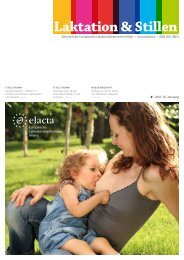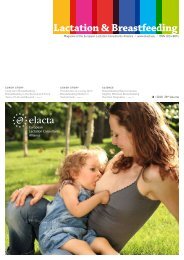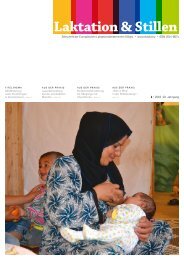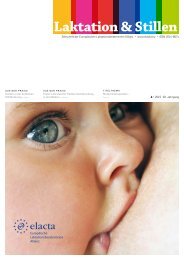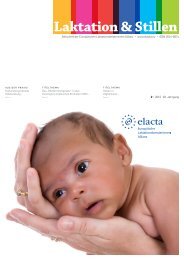Laktation_und_Stillen_2016-2 EN p1-8 web
Create successful ePaper yourself
Turn your PDF publications into a flip-book with our unique Google optimized e-Paper software.
4<br />
LETTER TO THE EDITOR<br />
Nipple Shields and reduced breastfeeding duration –<br />
is there a causal association?<br />
Letter to the editor: Does the Use of Nipple Shields Influence Breastfeeding Duration?<br />
With respect to the analysis of<br />
the data “Infant Nutrition Today,<br />
2006” regarding the use of nipple<br />
shields (<strong>Laktation</strong> & <strong>Stillen</strong>, 2015/4,<br />
pp. 20 – 24) and to the letter of Dr.<br />
phil. Zsuzsa Bauer (<strong>Laktation</strong> & <strong>Stillen</strong>,<br />
<strong>2016</strong>/1, p. 4) replying to the aforementioned<br />
article, I would like to add something<br />
to the topic:<br />
Many thanks to Mrs. Bauer for indicating<br />
the causal relationship and for her respectful<br />
and professional analysis of the study<br />
design. Her perfectly competent explanations<br />
confirmed me in my judgement.<br />
For several weeks now, the article lies<br />
on my desk and in the course of a comprehensive<br />
analysis of scientific work, I kept it<br />
at hand for reference and analysis. It elicited<br />
many content-related as well as formal<br />
discussions with colleagues in daily clinical<br />
practice.<br />
Every professional IBCLC must critically<br />
scrutinise their indication for the use of<br />
nipple shields and know about the consequences.<br />
This goes without saying.<br />
However, in the whole context of the<br />
usage and the controversial debate on pros<br />
and cons of nipple shields, one quite crucial<br />
factor is given insufficient attention:<br />
i.e. using a nipple shield restores self-efficacy<br />
to the mother-child dyad since breastfeeding<br />
would not be possible without<br />
the nipple shields. I work as an IBCLC at<br />
a “Baby-friendly Hospital” in Switzerland<br />
with more than 1000 deliveries a year and I<br />
frequently observe the in my opinion false<br />
ambition of weaning mother and child<br />
22<br />
SCI<strong>EN</strong>CE<br />
Does the Use of Nipple Shields Influence<br />
Breastfeeding Duration?<br />
Analysis of the Austrian study “Infant Feeding Today, 2006” Dr. Beate Pietschnig for “Österreichische Stillkommission des<br />
Obersten Sanitätsrates”, (2004–2010); translation: Elizabeth Hormann, IBCLC<br />
ABSTRACT:<br />
Backgro<strong>und</strong><br />
Nipple shields are frequently recommended<br />
at the beginning of breastfeeding<br />
to help mothers with sore nipples<br />
and with nipples with anomalies.<br />
Nipple shields are intended to enable<br />
mothers to breastfeed, although the<br />
data is very contradictory. The goal of<br />
the study was to examine the effects<br />
of nipple shields on breastfeeding<br />
duration.<br />
Material and Methods<br />
Data on the use of nipple shields in<br />
correlation to breastfeeding duration<br />
and the infant´s weight gain was collected<br />
and analyzed in the context<br />
of the study “Infant Feeding Today –<br />
2006”<br />
719 mothers of 728 children from all<br />
over Austria were qinterviewed three,<br />
six and 12 months after birth. 25 % of<br />
the 719 mothers were given a nipple<br />
shield postpartum, 52.7 % of them due<br />
to painful nipples.<br />
Results<br />
Infants who were breastfed with nipple<br />
shields at the beginning showed significantly<br />
shorter times of exclusive and<br />
partial breastfeeding. The weight gain<br />
patterns of the children did not show<br />
any significant differences.<br />
Conclusion<br />
The results show that nipple shields<br />
negatively influence the duration of<br />
breastfeeding. Thus, the uncriticial and<br />
unsupported use of nipple shields is<br />
not recommended.<br />
Keywords:<br />
› breastfeeding<br />
› breastfeeding counselling<br />
› nipple shields<br />
› breastfeeding duration<br />
xclusive breastfeeding for approximately<br />
the first six months of the<br />
E<br />
infant’s life is nationally and internationally<br />
recommended. 1, 5, 8, 9, 22 , as<br />
breastfeeding is amongst the most effective<br />
health-promoting measures in<br />
the health care system 3<br />
The use of nipple shields is recommended<br />
for treatment or prevention of<br />
pain and sore nipples and to ease attachment.<br />
Especially in anatomical variations<br />
(such as inverted or flat nipples) , nipple<br />
shields can enable breastfeeding at all On<br />
the other hand, nipple shields can lead to<br />
breastfeeding problems.<br />
Breastfeeding counsellors report that<br />
mothers are often given nipple shields in<br />
the first few days in hospital unreflected<br />
and without detailed information. In the<br />
related literature, there is little and very<br />
contradictory information on the benefits<br />
and risks of nipple shields. Although<br />
there are absolute (inverted nipples) and<br />
relative indications (i.e. flat nipples and,<br />
sometimes, premature babies) for the use<br />
of nipple shields, practice shows that nipple<br />
shields are also often recommended<br />
without specific indications. Consequences<br />
of the (unreflected) use of nipple shields include<br />
earlier supplementation and weaning<br />
of the baby.<br />
To evaluatethe outcome of early niplle<br />
shield use, the survey “Infant feeding Today<br />
2006”, was conducted to evaluate the<br />
use of nipple shields in the initial days of<br />
life. The survey was conducted on behalf<br />
of the Austrian Federal Ministry of Health<br />
and the Austrian Breastfeeding Committee,<br />
Methods<br />
In the Austrian study, “Infant Feeding<br />
2006”, two topics were evaluated : the<br />
structure of in – hospital care in the ob-<br />
www.elacta.eu Lactation & Breastfeeding 4 • 2015<br />
from the nipple shields, however well-intentioned,<br />
although breastfeeding management<br />
works well.<br />
While it is true that we as lactation<br />
consultants during puerperium or as freelancer<br />
midwives (after birth) can support<br />
mother and child to establish a good latch,<br />
but what happens if they at home or elsewhere<br />
fail to latch without our professional<br />
support? Some might argue that it must be<br />
dealt with correctly from the start, and this<br />
is perfectly justifiable. However, in daily<br />
routine the reality is somewhat different.<br />
And everyone who cares for mother and<br />
child over several days in every shift according<br />
to primary nursing concept in a<br />
hospital with 24-hour operation (and not<br />
merely during a one-to-one consultation)<br />
knows the situation of not reaching the<br />
aim without the use of nipple shields despite<br />
all efforts and interventions: The aim<br />
is to support mother and child to develop a<br />
successful breastfeeding relationship. That<br />
is why I would not advocate a positive ethics<br />
committee vote regarding experimental<br />
studies involving the impact of nipple<br />
shields on breastfeeding duration, since it<br />
would involve depriving mother-child dyads<br />
of a useful intervention.<br />
In my daily routine as a breastfeeding<br />
consultant, women suffering from breast<br />
engorgement or mastitis attend my outpatient<br />
counselling service because in aftercare<br />
too little attention is paid to the new<br />
situation of being at home. In my personal<br />
experience, the use of nipple shields has a<br />
rehabilitative character, due to the principle:<br />
“Help me do it myself!”<br />
With respect to the debate on nipple<br />
shields, reference is made to a review that<br />
was published in October 2015: “The use<br />
of nipple shields: a review”; Chow et al.;<br />
doi:10.3389/fpubh.2015.00236.<br />
This review was conducted to evaluate<br />
the evidence and outcomes that are associated<br />
with the use of nipple shields.<br />
Claudia Wronski El Awamry<br />
Registered nurse<br />
IBCLC at the “Baby-friendly Hospital”<br />
Limmattal, Switzerland.<br />
www.elacta.eu Lactation & Breastfeeding 2 • <strong>2016</strong>



